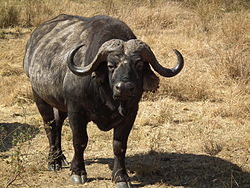The biological subfamily Bovinae includes a diverse group of 10 genera of medium to large-sized ungulates, including domestic cattle, bison, African buffalo, the water buffalo, the yak, and the four-horned and spiral-horned antelopes. The evolutionary relationship between the members of the group is obscure, and their classification into loose tribes rather than formal subgroups reflects this uncertainty. General characteristics include cloven hoofs and usually at least one of the sexes of a species having true horns. The largest extant bovine is the gaur.
In most countries, bovids are used for food. Cattle are eaten almost everywhere, but in parts of India and Nepal bovids are considered sacred by most Hindus.
Systematics and classification

- FAMILY BOVIDAE
- Subfamily Bovinae
- Tribe Boselaphini
- Genus Tetracerus
- Four-horned antelope, Tetracerus quadricornis
- T.q. quadricornis
- T.q. iodes
- T.q. subquadricornis
- Four-horned antelope, Tetracerus quadricornis
- Genus Boselaphus
- Nilgai or blue bull, Boselaphus tragocamelus (not to be confused with the extinct bluebuck Hippotragus leucophaeus, Hippotraginae)
- B.t. tragocamelus (Indian nilgai)
- Nilgai or blue bull, Boselaphus tragocamelus (not to be confused with the extinct bluebuck Hippotragus leucophaeus, Hippotraginae)
- Genus Tetracerus
- Tribe Bovini
- Genus Bubalus
- Water buffalo, Bubalus bubalis
- Wild Asian water buffalo, Bubalus arnee
- Lowland anoa, Bubalus depressicornis
- Mountain anoa, Bubalus quarlesi
- Tamaraw, Bubalus mindorensis
- Cebu tamaraw†, Bubalus cebuensis (extinct)
- Genus Bos
- Aurochs†, Bos primigenius (extinct)
- Banteng, Bos javanicus
- Gaur, Bos gaurus
- Gayal, Bos frontalis (domestic gaur)
- Yak, Bos mutus, Bos grunniens
- Bos palaesondaicus†, (extinct)
- Domestic cattle, Bos taurus
- Domestic zebu, Bos indicus
- Kouprey, Bos sauveli
- Genus Pseudoryx
- Saola, Pseudoryx nghetinhensis
- Genus Syncerus
- African buffalo, Syncerus caffer
- Genus Bison
- American bison, Bison bison
- Wisent, Bison bonasus
- Bison palaeosinensis†, (extinct)
- Steppe wisent†, Bison priscus (extinct)
- Ancient bison†, Bison antiquus (extinct)
- Long-horned bison†, Bison latifrons (extinct)
- Genus Pelorovis†(extinct)
- Giant buffalo†, Pelorovis antiquus (extinct)
- Genus Bubalus
- Tribe Strepsicerotini
- Genus Tragelaphus (antelope-like)
- Bongo, Tragelaphus eurycerus
- Greater kudu, Tragelaphus strepsiceros
- Kéwel, Tragelaphus scriptus
- Imbabala, Tragelaphus sylvaticus
- Lesser kudu, Tragelaphus imberbis
- Mountain nyala, Tragelaphus buxtoni
- Nyala, Tragelaphus angasii
- Sitatunga, Tragelaphus spekeii
- Genus Taurotragus
- Common eland, Taurotragus oryx
- Giant eland, Taurotragus derbianus
- Genus Tragelaphus (antelope-like)
- Tribe Boselaphini
- Subfamily Bovinae
Etymology

Bovine is derived from Latin bos, "ox", through Late Latin bovinus. Bos comes from the Indo-European root *gwous, meaning ox.
See also

- Bovine submaxillary mucin coatings
References
- International Commission on Zoological Nomenclature. 2003. Opinion 2027 (Case 3010). Usage of 17Î"бÐ" specific names based on wild species which are pre-dated by or contemporary with those based on domestic animals(Lepidoptera, Osteichthyes, Mammalia): conserved. Bull.Zool.Nomencl., 60:81â€"84.
External links
- Bovinae information in ITIS.
- Congress on Controversies in Bovine Health, Industry & Economics (CoBo)




0 komentar :
Posting Komentar